Health Financial Management: PBS and Medicine Consumption
VerifiedAdded on 2023/06/07
|15
|2500
|394
Report
AI Summary
This report provides a comprehensive analysis of the Australian Pharmaceutical Benefits Scheme (PBS). It begins with an executive summary and table of contents, followed by an introduction to the PBS, its objectives, and the medicines subsidized under it, including special arrangements, veteran's medicines, and general medicines. The report presents statistics on drug consumption in Australia, including consumption trends, prescription numbers by ATC groups, and drugs under co-payment prescriptions. It also covers the financial implications of the PBS, detailing the financial impact on the health sector, consumer contributions, and the Australian government. Furthermore, the report offers recommendations for sustaining the PBS and ensuring equitable access to medicines, including changes in copayments, public policy forums, and consumer education. The conclusion summarizes the significance of the PBS in Australia, emphasizing its role in providing affordable access to medicines and its associated financial implications.

HEALTH FINANCIAL MANAGEMENT 1
Health Financial Management
Student’s Name
Institution Affiliate
Date
Health Financial Management
Student’s Name
Institution Affiliate
Date
Paraphrase This Document
Need a fresh take? Get an instant paraphrase of this document with our AI Paraphraser
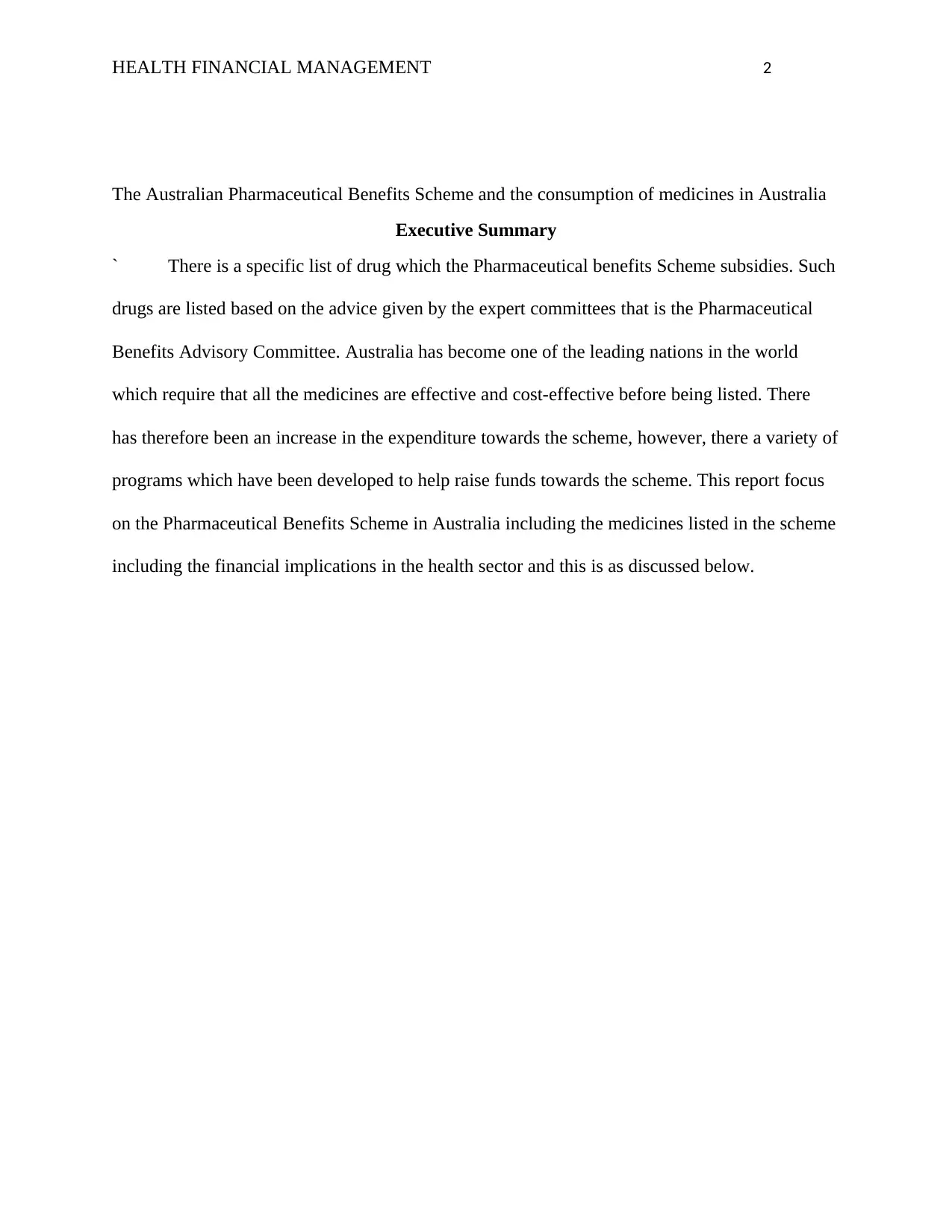
HEALTH FINANCIAL MANAGEMENT 2
The Australian Pharmaceutical Benefits Scheme and the consumption of medicines in Australia
Executive Summary
` There is a specific list of drug which the Pharmaceutical benefits Scheme subsidies. Such
drugs are listed based on the advice given by the expert committees that is the Pharmaceutical
Benefits Advisory Committee. Australia has become one of the leading nations in the world
which require that all the medicines are effective and cost-effective before being listed. There
has therefore been an increase in the expenditure towards the scheme, however, there a variety of
programs which have been developed to help raise funds towards the scheme. This report focus
on the Pharmaceutical Benefits Scheme in Australia including the medicines listed in the scheme
including the financial implications in the health sector and this is as discussed below.
The Australian Pharmaceutical Benefits Scheme and the consumption of medicines in Australia
Executive Summary
` There is a specific list of drug which the Pharmaceutical benefits Scheme subsidies. Such
drugs are listed based on the advice given by the expert committees that is the Pharmaceutical
Benefits Advisory Committee. Australia has become one of the leading nations in the world
which require that all the medicines are effective and cost-effective before being listed. There
has therefore been an increase in the expenditure towards the scheme, however, there a variety of
programs which have been developed to help raise funds towards the scheme. This report focus
on the Pharmaceutical Benefits Scheme in Australia including the medicines listed in the scheme
including the financial implications in the health sector and this is as discussed below.
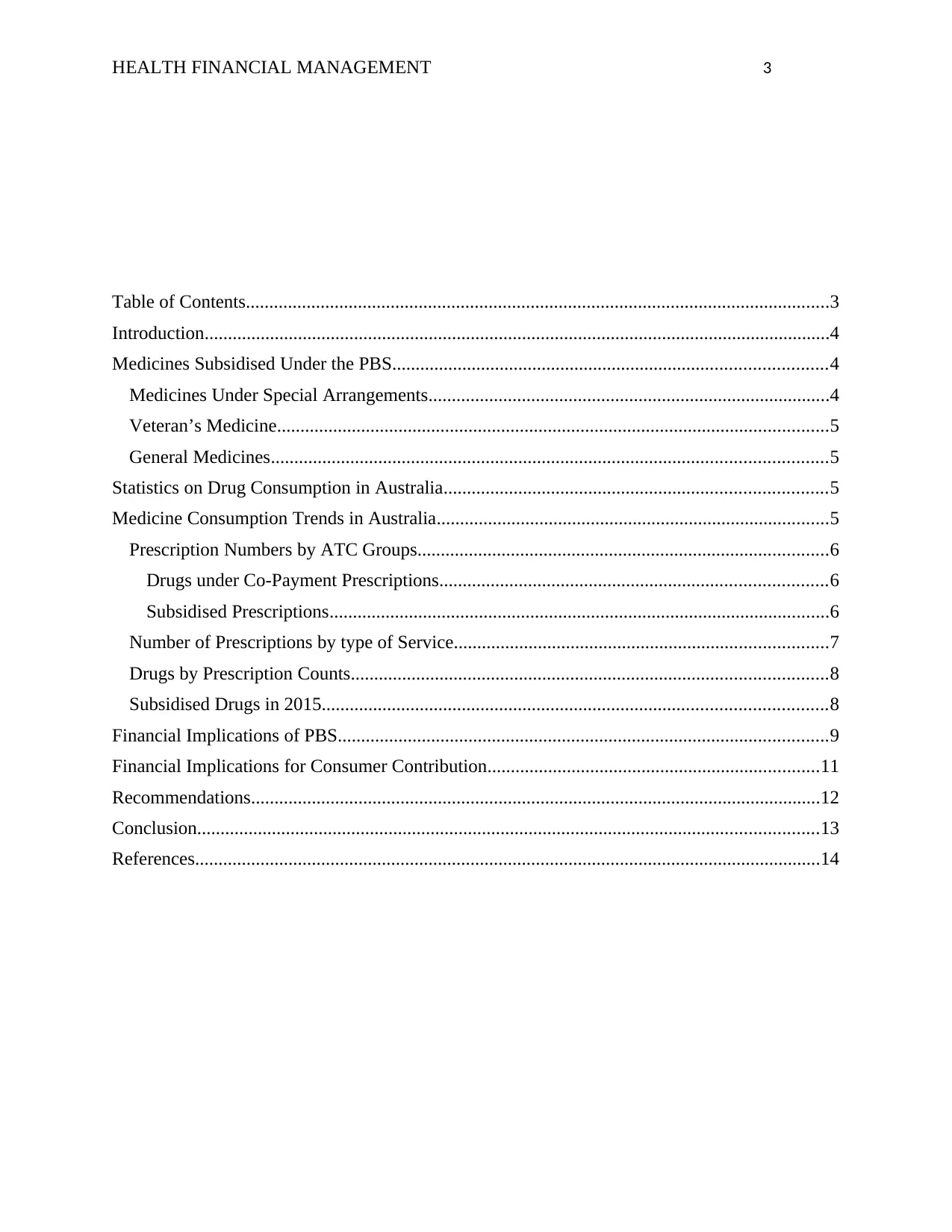
HEALTH FINANCIAL MANAGEMENT 3
Table of Contents.............................................................................................................................3
Introduction......................................................................................................................................4
Medicines Subsidised Under the PBS.............................................................................................4
Medicines Under Special Arrangements......................................................................................4
Veteran’s Medicine......................................................................................................................5
General Medicines.......................................................................................................................5
Statistics on Drug Consumption in Australia..................................................................................5
Medicine Consumption Trends in Australia....................................................................................5
Prescription Numbers by ATC Groups........................................................................................6
Drugs under Co-Payment Prescriptions...................................................................................6
Subsidised Prescriptions...........................................................................................................6
Number of Prescriptions by type of Service................................................................................7
Drugs by Prescription Counts......................................................................................................8
Subsidised Drugs in 2015............................................................................................................8
Financial Implications of PBS.........................................................................................................9
Financial Implications for Consumer Contribution.......................................................................11
Recommendations..........................................................................................................................12
Conclusion.....................................................................................................................................13
References......................................................................................................................................14
Table of Contents.............................................................................................................................3
Introduction......................................................................................................................................4
Medicines Subsidised Under the PBS.............................................................................................4
Medicines Under Special Arrangements......................................................................................4
Veteran’s Medicine......................................................................................................................5
General Medicines.......................................................................................................................5
Statistics on Drug Consumption in Australia..................................................................................5
Medicine Consumption Trends in Australia....................................................................................5
Prescription Numbers by ATC Groups........................................................................................6
Drugs under Co-Payment Prescriptions...................................................................................6
Subsidised Prescriptions...........................................................................................................6
Number of Prescriptions by type of Service................................................................................7
Drugs by Prescription Counts......................................................................................................8
Subsidised Drugs in 2015............................................................................................................8
Financial Implications of PBS.........................................................................................................9
Financial Implications for Consumer Contribution.......................................................................11
Recommendations..........................................................................................................................12
Conclusion.....................................................................................................................................13
References......................................................................................................................................14
⊘ This is a preview!⊘
Do you want full access?
Subscribe today to unlock all pages.

Trusted by 1+ million students worldwide

HEALTH FINANCIAL MANAGEMENT 4
Introduction
The Australian Pharmaceutical Benefits Scheme forms one among the national policy
medicinal drug policy in Australia. The scheme typically offers access to various medicines for
the citizens of Australia. This policy aims at ensuring that there is the quality use of a variety of
medicines and it is done by a body known as the Pharmaceutical Health And the Rational use of
Medicine Committee. It also helps to ensure that the medicinal products are safe and of quality, a
fundamental role played by the Therapeutic Goods Administration. The scheme began in the
1950s, and during those days, it supplied 140 infection prevention and lifesaving drugs. However
it has grown over the years, and it currently offers subsidies for curing some of the medicinal
conditions among various individuals (Hollingworth, Chan, Pham, Shi & Ford, 2017). The
primary aim for the established of the Australian Pharmaceutical Benefits Scheme was to help
meet some of the prescriptions and need of the society as was stipulated by the medical
practitioners. Apart from the patients in public hospitals receiving the PBS, those in the private
hospitals also have access to the scheme. The states, territories, and commonwealth are
responsible for the provision of the drugs in the public hospitals through funding based on the
Medicare agreement. Additionally, there are certain high-cost drugs whose supplies are from the
hospitals to the outpatients and such are funded by the Commonwealth
Medicines Subsidised Under the PBS
The medicines subsidized under the PBS include;
Introduction
The Australian Pharmaceutical Benefits Scheme forms one among the national policy
medicinal drug policy in Australia. The scheme typically offers access to various medicines for
the citizens of Australia. This policy aims at ensuring that there is the quality use of a variety of
medicines and it is done by a body known as the Pharmaceutical Health And the Rational use of
Medicine Committee. It also helps to ensure that the medicinal products are safe and of quality, a
fundamental role played by the Therapeutic Goods Administration. The scheme began in the
1950s, and during those days, it supplied 140 infection prevention and lifesaving drugs. However
it has grown over the years, and it currently offers subsidies for curing some of the medicinal
conditions among various individuals (Hollingworth, Chan, Pham, Shi & Ford, 2017). The
primary aim for the established of the Australian Pharmaceutical Benefits Scheme was to help
meet some of the prescriptions and need of the society as was stipulated by the medical
practitioners. Apart from the patients in public hospitals receiving the PBS, those in the private
hospitals also have access to the scheme. The states, territories, and commonwealth are
responsible for the provision of the drugs in the public hospitals through funding based on the
Medicare agreement. Additionally, there are certain high-cost drugs whose supplies are from the
hospitals to the outpatients and such are funded by the Commonwealth
Medicines Subsidised Under the PBS
The medicines subsidized under the PBS include;
Paraphrase This Document
Need a fresh take? Get an instant paraphrase of this document with our AI Paraphraser
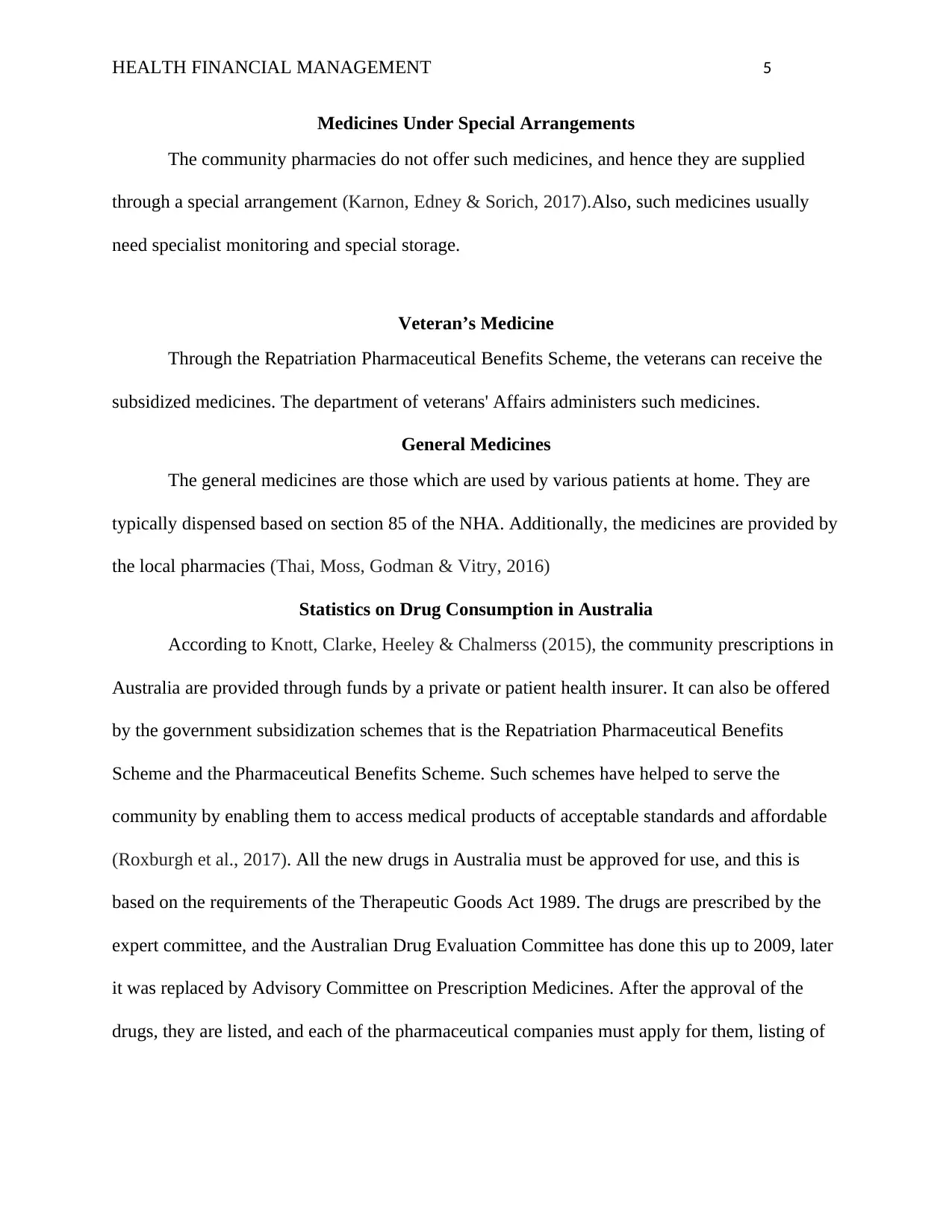
HEALTH FINANCIAL MANAGEMENT 5
Medicines Under Special Arrangements
The community pharmacies do not offer such medicines, and hence they are supplied
through a special arrangement (Karnon, Edney & Sorich, 2017).Also, such medicines usually
need specialist monitoring and special storage.
Veteran’s Medicine
Through the Repatriation Pharmaceutical Benefits Scheme, the veterans can receive the
subsidized medicines. The department of veterans' Affairs administers such medicines.
General Medicines
The general medicines are those which are used by various patients at home. They are
typically dispensed based on section 85 of the NHA. Additionally, the medicines are provided by
the local pharmacies (Thai, Moss, Godman & Vitry, 2016)
Statistics on Drug Consumption in Australia
According to Knott, Clarke, Heeley & Chalmerss (2015), the community prescriptions in
Australia are provided through funds by a private or patient health insurer. It can also be offered
by the government subsidization schemes that is the Repatriation Pharmaceutical Benefits
Scheme and the Pharmaceutical Benefits Scheme. Such schemes have helped to serve the
community by enabling them to access medical products of acceptable standards and affordable
(Roxburgh et al., 2017). All the new drugs in Australia must be approved for use, and this is
based on the requirements of the Therapeutic Goods Act 1989. The drugs are prescribed by the
expert committee, and the Australian Drug Evaluation Committee has done this up to 2009, later
it was replaced by Advisory Committee on Prescription Medicines. After the approval of the
drugs, they are listed, and each of the pharmaceutical companies must apply for them, listing of
Medicines Under Special Arrangements
The community pharmacies do not offer such medicines, and hence they are supplied
through a special arrangement (Karnon, Edney & Sorich, 2017).Also, such medicines usually
need specialist monitoring and special storage.
Veteran’s Medicine
Through the Repatriation Pharmaceutical Benefits Scheme, the veterans can receive the
subsidized medicines. The department of veterans' Affairs administers such medicines.
General Medicines
The general medicines are those which are used by various patients at home. They are
typically dispensed based on section 85 of the NHA. Additionally, the medicines are provided by
the local pharmacies (Thai, Moss, Godman & Vitry, 2016)
Statistics on Drug Consumption in Australia
According to Knott, Clarke, Heeley & Chalmerss (2015), the community prescriptions in
Australia are provided through funds by a private or patient health insurer. It can also be offered
by the government subsidization schemes that is the Repatriation Pharmaceutical Benefits
Scheme and the Pharmaceutical Benefits Scheme. Such schemes have helped to serve the
community by enabling them to access medical products of acceptable standards and affordable
(Roxburgh et al., 2017). All the new drugs in Australia must be approved for use, and this is
based on the requirements of the Therapeutic Goods Act 1989. The drugs are prescribed by the
expert committee, and the Australian Drug Evaluation Committee has done this up to 2009, later
it was replaced by Advisory Committee on Prescription Medicines. After the approval of the
drugs, they are listed, and each of the pharmaceutical companies must apply for them, listing of
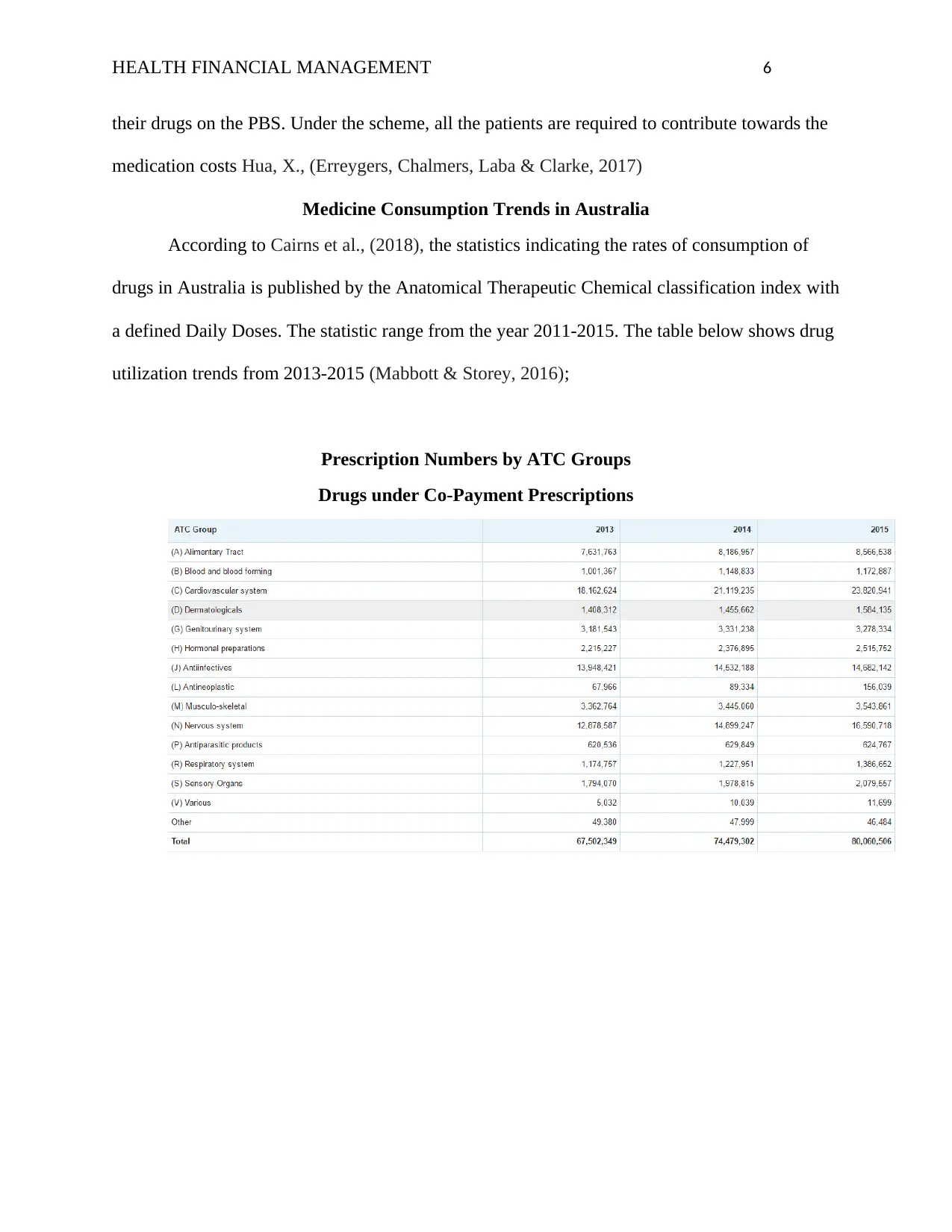
HEALTH FINANCIAL MANAGEMENT 6
their drugs on the PBS. Under the scheme, all the patients are required to contribute towards the
medication costs Hua, X., (Erreygers, Chalmers, Laba & Clarke, 2017)
Medicine Consumption Trends in Australia
According to Cairns et al., (2018), the statistics indicating the rates of consumption of
drugs in Australia is published by the Anatomical Therapeutic Chemical classification index with
a defined Daily Doses. The statistic range from the year 2011-2015. The table below shows drug
utilization trends from 2013-2015 (Mabbott & Storey, 2016);
Prescription Numbers by ATC Groups
Drugs under Co-Payment Prescriptions
their drugs on the PBS. Under the scheme, all the patients are required to contribute towards the
medication costs Hua, X., (Erreygers, Chalmers, Laba & Clarke, 2017)
Medicine Consumption Trends in Australia
According to Cairns et al., (2018), the statistics indicating the rates of consumption of
drugs in Australia is published by the Anatomical Therapeutic Chemical classification index with
a defined Daily Doses. The statistic range from the year 2011-2015. The table below shows drug
utilization trends from 2013-2015 (Mabbott & Storey, 2016);
Prescription Numbers by ATC Groups
Drugs under Co-Payment Prescriptions
⊘ This is a preview!⊘
Do you want full access?
Subscribe today to unlock all pages.

Trusted by 1+ million students worldwide
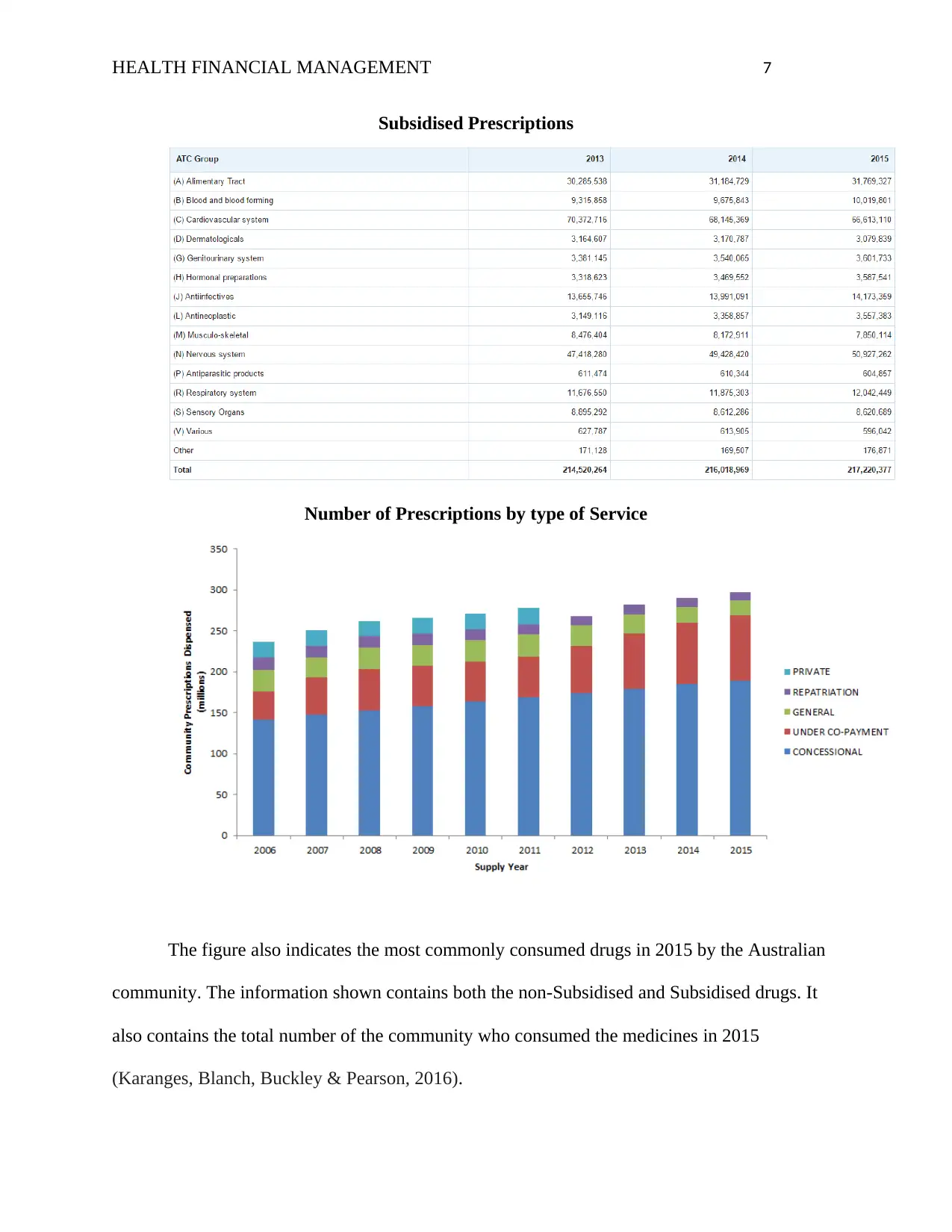
HEALTH FINANCIAL MANAGEMENT 7
Subsidised Prescriptions
Number of Prescriptions by type of Service
The figure also indicates the most commonly consumed drugs in 2015 by the Australian
community. The information shown contains both the non-Subsidised and Subsidised drugs. It
also contains the total number of the community who consumed the medicines in 2015
(Karanges, Blanch, Buckley & Pearson, 2016).
Subsidised Prescriptions
Number of Prescriptions by type of Service
The figure also indicates the most commonly consumed drugs in 2015 by the Australian
community. The information shown contains both the non-Subsidised and Subsidised drugs. It
also contains the total number of the community who consumed the medicines in 2015
(Karanges, Blanch, Buckley & Pearson, 2016).
Paraphrase This Document
Need a fresh take? Get an instant paraphrase of this document with our AI Paraphraser

HEALTH FINANCIAL MANAGEMENT 8
Drugs by Prescription Counts
The diagram below displays the top medicines which were consumed in 2015 by the Australian
community;
Subsidised Drugs in 2015
The figure below illustrates the top ten subsidised medicines in 2015;
Drugs by Prescription Counts
The diagram below displays the top medicines which were consumed in 2015 by the Australian
community;
Subsidised Drugs in 2015
The figure below illustrates the top ten subsidised medicines in 2015;
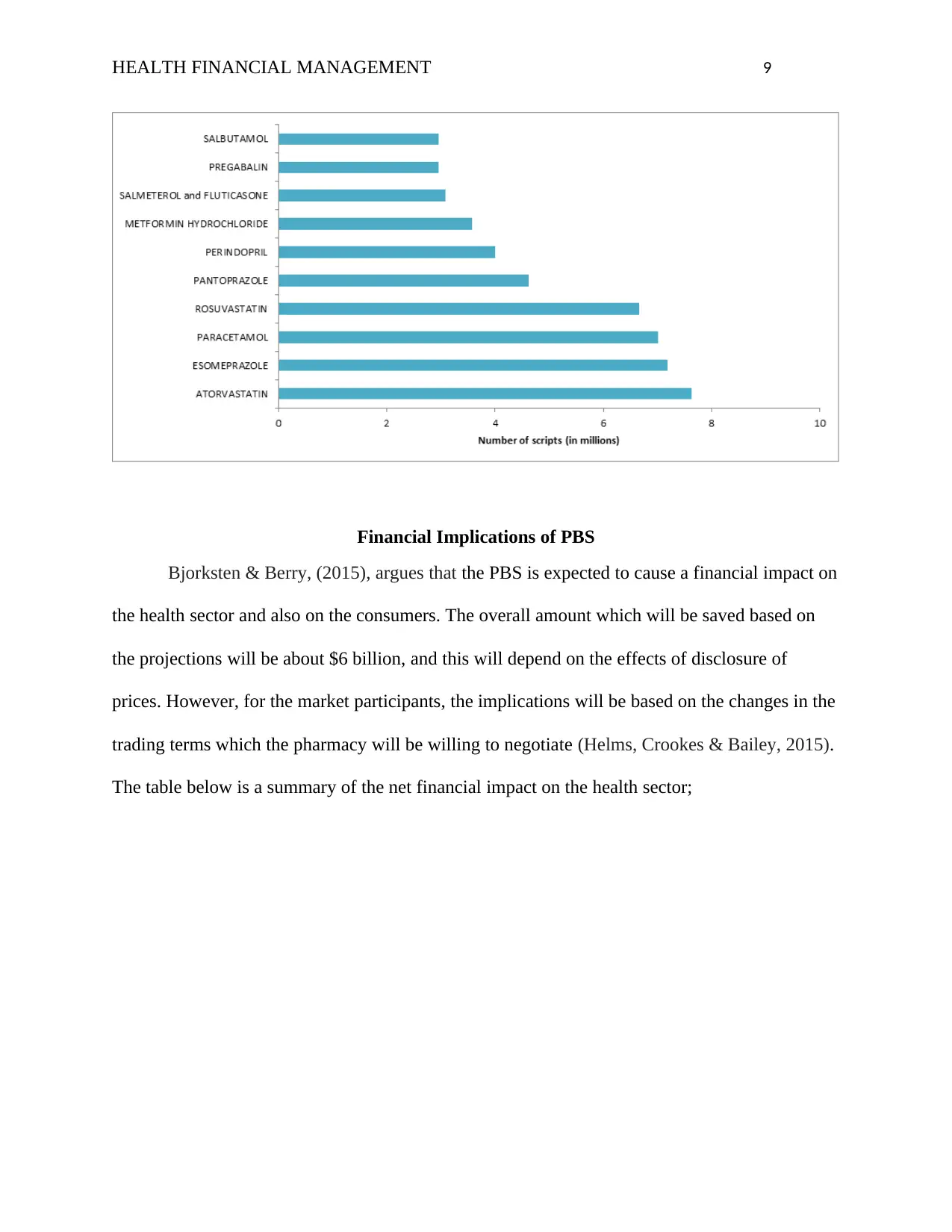
HEALTH FINANCIAL MANAGEMENT 9
Financial Implications of PBS
Bjorksten & Berry, (2015), argues that the PBS is expected to cause a financial impact on
the health sector and also on the consumers. The overall amount which will be saved based on
the projections will be about $6 billion, and this will depend on the effects of disclosure of
prices. However, for the market participants, the implications will be based on the changes in the
trading terms which the pharmacy will be willing to negotiate (Helms, Crookes & Bailey, 2015).
The table below is a summary of the net financial impact on the health sector;
Financial Implications of PBS
Bjorksten & Berry, (2015), argues that the PBS is expected to cause a financial impact on
the health sector and also on the consumers. The overall amount which will be saved based on
the projections will be about $6 billion, and this will depend on the effects of disclosure of
prices. However, for the market participants, the implications will be based on the changes in the
trading terms which the pharmacy will be willing to negotiate (Helms, Crookes & Bailey, 2015).
The table below is a summary of the net financial impact on the health sector;
⊘ This is a preview!⊘
Do you want full access?
Subscribe today to unlock all pages.

Trusted by 1+ million students worldwide
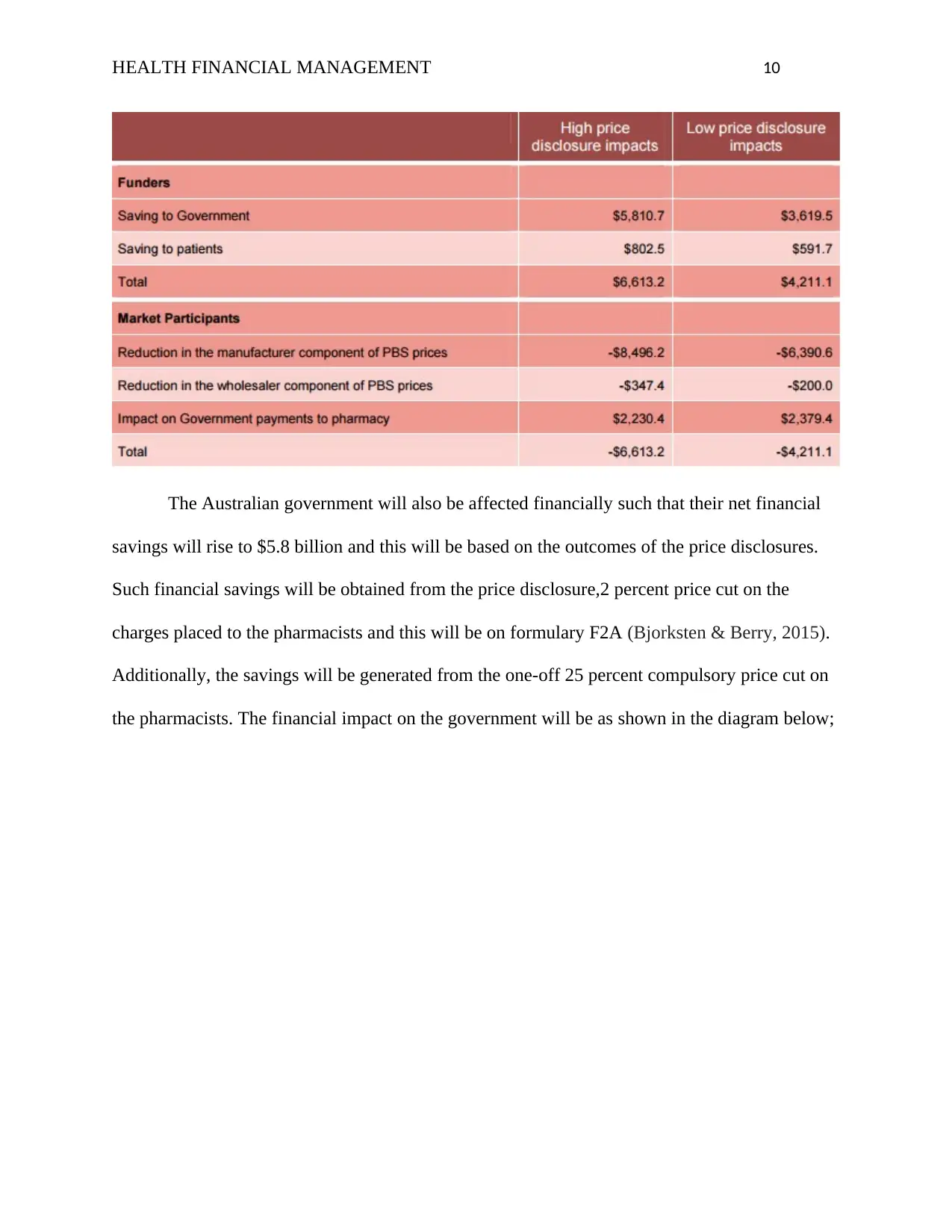
HEALTH FINANCIAL MANAGEMENT 10
The Australian government will also be affected financially such that their net financial
savings will rise to $5.8 billion and this will be based on the outcomes of the price disclosures.
Such financial savings will be obtained from the price disclosure,2 percent price cut on the
charges placed to the pharmacists and this will be on formulary F2A (Bjorksten & Berry, 2015).
Additionally, the savings will be generated from the one-off 25 percent compulsory price cut on
the pharmacists. The financial impact on the government will be as shown in the diagram below;
The Australian government will also be affected financially such that their net financial
savings will rise to $5.8 billion and this will be based on the outcomes of the price disclosures.
Such financial savings will be obtained from the price disclosure,2 percent price cut on the
charges placed to the pharmacists and this will be on formulary F2A (Bjorksten & Berry, 2015).
Additionally, the savings will be generated from the one-off 25 percent compulsory price cut on
the pharmacists. The financial impact on the government will be as shown in the diagram below;
Paraphrase This Document
Need a fresh take? Get an instant paraphrase of this document with our AI Paraphraser
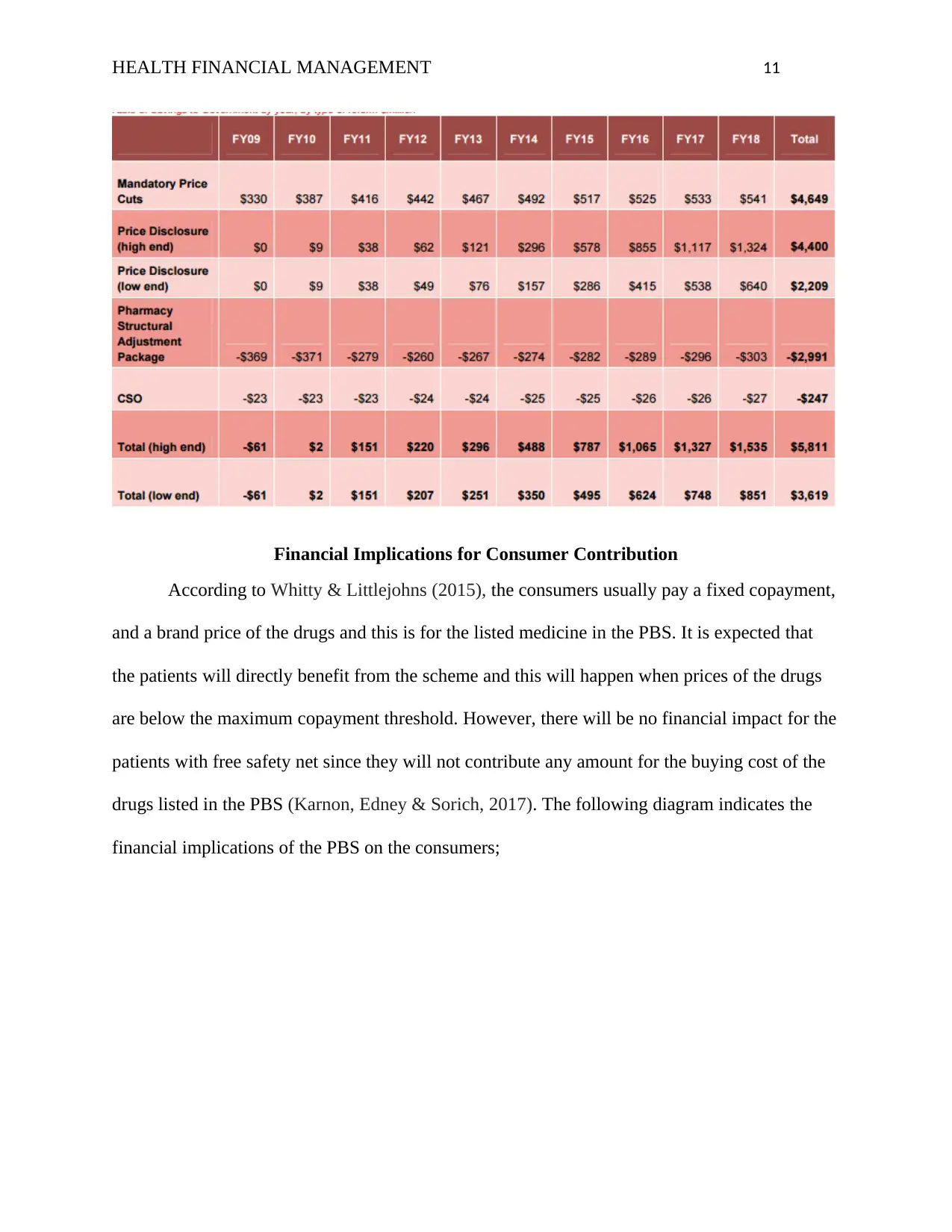
HEALTH FINANCIAL MANAGEMENT 11
Financial Implications for Consumer Contribution
According to Whitty & Littlejohns (2015), the consumers usually pay a fixed copayment,
and a brand price of the drugs and this is for the listed medicine in the PBS. It is expected that
the patients will directly benefit from the scheme and this will happen when prices of the drugs
are below the maximum copayment threshold. However, there will be no financial impact for the
patients with free safety net since they will not contribute any amount for the buying cost of the
drugs listed in the PBS (Karnon, Edney & Sorich, 2017). The following diagram indicates the
financial implications of the PBS on the consumers;
Financial Implications for Consumer Contribution
According to Whitty & Littlejohns (2015), the consumers usually pay a fixed copayment,
and a brand price of the drugs and this is for the listed medicine in the PBS. It is expected that
the patients will directly benefit from the scheme and this will happen when prices of the drugs
are below the maximum copayment threshold. However, there will be no financial impact for the
patients with free safety net since they will not contribute any amount for the buying cost of the
drugs listed in the PBS (Karnon, Edney & Sorich, 2017). The following diagram indicates the
financial implications of the PBS on the consumers;

HEALTH FINANCIAL MANAGEMENT 12
Recommendations
The key priority of the Australian government for both the present and future generations
by ensuring that there is equitable access to medicines would be by sustaining the
Pharmaceutical Benefits Scheme. It is expected that a change in the copayments should be aimed
at ensuring the principle of equity is applied. The application of such a principle will help
provide protection to the individuals with chronic conditions and hence would need self-
maintenance in the society. Also, the people of the community should be made aware of their
entitlements, and this should be through the PBS. There should be a public policy forum to
discuss the means to finance the PBS to ensure affordable access to the fundamental medicines.
Further, there should be more resources made available for educating the consumers and the
prescribers on the use and even roles of the drugs to prevent illness and maintain health. To
sustain the PBS for a long time, the following recommendations should be done;
There should be more information provided to the prescribers and consumers on the
purpose of generic medicines and methods to save for the prescribed drugs. The consumers
should also be given access to the consumer medicine information to educate them on the non-
drug techniques towards prevention of further illness. Also, such information would also enable
Recommendations
The key priority of the Australian government for both the present and future generations
by ensuring that there is equitable access to medicines would be by sustaining the
Pharmaceutical Benefits Scheme. It is expected that a change in the copayments should be aimed
at ensuring the principle of equity is applied. The application of such a principle will help
provide protection to the individuals with chronic conditions and hence would need self-
maintenance in the society. Also, the people of the community should be made aware of their
entitlements, and this should be through the PBS. There should be a public policy forum to
discuss the means to finance the PBS to ensure affordable access to the fundamental medicines.
Further, there should be more resources made available for educating the consumers and the
prescribers on the use and even roles of the drugs to prevent illness and maintain health. To
sustain the PBS for a long time, the following recommendations should be done;
There should be more information provided to the prescribers and consumers on the
purpose of generic medicines and methods to save for the prescribed drugs. The consumers
should also be given access to the consumer medicine information to educate them on the non-
drug techniques towards prevention of further illness. Also, such information would also enable
⊘ This is a preview!⊘
Do you want full access?
Subscribe today to unlock all pages.

Trusted by 1+ million students worldwide
1 out of 15
Related Documents
Your All-in-One AI-Powered Toolkit for Academic Success.
+13062052269
info@desklib.com
Available 24*7 on WhatsApp / Email
![[object Object]](/_next/static/media/star-bottom.7253800d.svg)
Unlock your academic potential
Copyright © 2020–2026 A2Z Services. All Rights Reserved. Developed and managed by ZUCOL.





